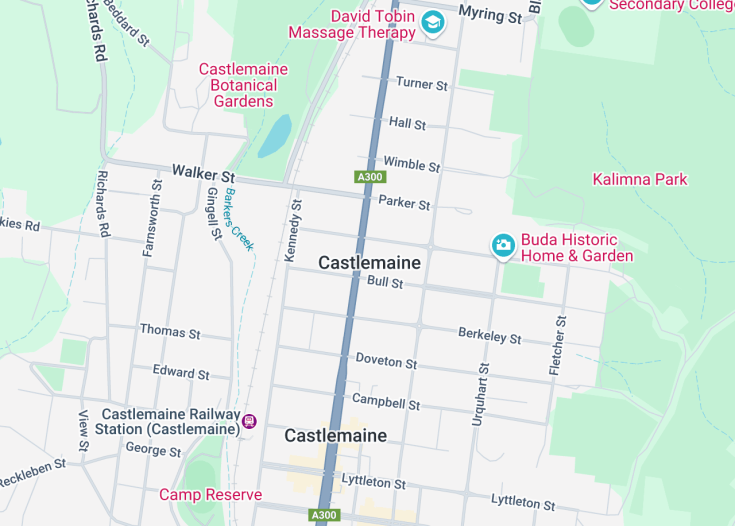Castlemaine, a charming country town nestled in the heart of Victoria, Australia, is renowned for its rich gold rush history, vibrant arts scene, and scenic natural surroundings. A hub for creatives and history buffs alike, it offers a plethora of attractions, from the historical Castlemaine Art Museum to the lush Diggings National Heritage Park.
This picturesque town provides the perfect escape into Australia’s colonial past and thriving contemporary culture, offering an enriching experience for all visitors.
Before visiting Castlemaine, make sure to check the local events calendar as the town often hosts art exhibits and cultural festivals that are not to be missed.
Exploring the surrounding Goldfields region by bike is highly recommended, offering a unique perspective of Castlemaine’s enchanting landscapes and historic sites.
Top things to do & see in Castlemaine
Select the following sights and activities to discover best tickets and tours available in Castlemaine.
Castlemaine: A Gem in the Goldfields
| Country | Australia |
| Time in Castlemaine | GMT+11 |
| Language spoken | English |
| Population | 6,757 (source: latest census data) |
| Currency | Australian Dollar (AUD $) |
| Airports |
|
Castlemaine, a picturesque town in the heart of Victoria, Australia, is steeped in a rich history dating back to its establishment during the Victorian gold rush. Today, it offers a charming blend of historical attractions and modern amenities, making it a popular destination for both tourists and residents.
The town’s well-preserved Victorian architecture provides a backdrop to an array of arts, culture, and culinary experiences. The Castlemaine Art Museum, historic Theatre Royal, and the lush Castlemaine Botanical Gardens are notable highlights. The town also boasts a vibrant community atmosphere, hosting several festivals throughout the year that celebrate its diverse culture and history.
Where is Castlemaine?
Located in the state of Victoria, Australia, Castlemaine lies at the heart of the Goldfields region, surrounded by rolling hills and rugged landscapes.
Distances:
| Route | Distance by car | Time by car |
| Melbourne to Castlemaine | 120 km | 1 hour 30 minutes |
| Bendigo to Castlemaine | 40 km | 35 minutes |
What is Castlemainefamous for?
Castlemaine is renowned for its historical significance as a major center during the Australian gold rush. It’s famous for its beautifully preserved Victorian architecture, captivating museums, and as a haven for artists and foodies.
History
Castlemaine, located in Victoria, Australia, boasts a rich and varied history that spans from ancient times through to the modern day. The area’s story is marked by significant transformations, providing insight into both the cultural and socio-economic shifts of the region.[/ct-bullets]
Pre-1830s: Indigenous Heritage
Prior to European settlement, the region where Castlemaine now lies was inhabited by the Dja Dja Wurrung people. This indigenous community lived harmoniously with the land, thriving on the natural resources available in the area. Their rich cultural traditions, knowledge of the flora and fauna, and spiritual beliefs were deeply intertwined with the surrounding landscape.
1830s-1851: European Discovery and Early Settlement
The first European explorers arrived in the 1830s, quickly followed by settlers. Major Mitchell, a prominent explorer, passed through the area in 1836, paving the way for early settlers who established pastoral runs. However, the discovery of gold in 1851 transformed Castlemaine from a small pastoral community into a thriving centre during the Victorian Gold Rush.
1851-1900: The Gold Rush Era
The discovery of gold at Specimen Gully in Castlemaine by Christopher Thomas Peters in 1851 marked the beginning of an era that would reshape the entire region. The population boomed as prospectors flooded into the area, leading to a rapidly expanding settlement. The town was officially named Castlemaine in honor of Viscount Castlemaine. Infrastructure developed quickly to support the growing community, including roads, schools, and shops.
1901-Present: Growth and Evolution
Following the decline of gold mining, Castlemaine evolved into a manufacturing and agricultural hub. Its rich history has been preserved in many of the town’s heritage buildings, which today house museums and art galleries, contributing to the town’s cultural fabric. In recent years, Castlemaine has gained recognition for its vibrant arts scene, reflecting a community deeply engaged with both its past and its future.
Visit Castlemaine
What to see and do in Castlemaine
Castlemaine is a treasure trove of historical and cultural attractions. Key highlights include:
- The Castlemaine Art Museum, known for its impressive collection of Australian art.
- The historic Castlemaine Railway Station, which features Victorian-era architecture.
- Exploring the fascinating remnants of the gold rush era throughout the town.
- Buda Historic Home & Garden, showcasing 19th-century lifestyle and art.
For nature enthusiasts, the nearby Castlemaine Diggings National Heritage Park offers excellent opportunities for bushwalking and exploring gold rush relics.
Festivals and Events
Castlemaine hosts several notable events throughout the year, enriching its cultural landscape. These include the Castlemaine State Festival, a biennial arts festival held in March, and the Castlemaine Jazz Festival in June. Both events attract artists and audiences from across Australia and beyond, making them significant dates in the town’s cultural calendar.
Best time to visit Castlemaine
The best time to visit Castlemaine is during the autumn months, from March to May. During this season, the weather is pleasantly cool, and the town’s foliage transforms into vibrant shades of red, orange, and yellow, providing a stunning backdrop for its historical sites.
Is Castlemaine worth visiting?
Castlemaine offers a compelling blend of history, art, and nature, making it a noteworthy destination. While its rich cultural heritage and vibrant arts scene are major draws, the limited nightlife and relatively quiet social scene may not appeal to everyone.
However, for those interested in Australian history, culture, and natural beauty, Castlemaine presents a fulfilling getaway. Visitors should be prepared for a quieter, but deeply enriching experience.









